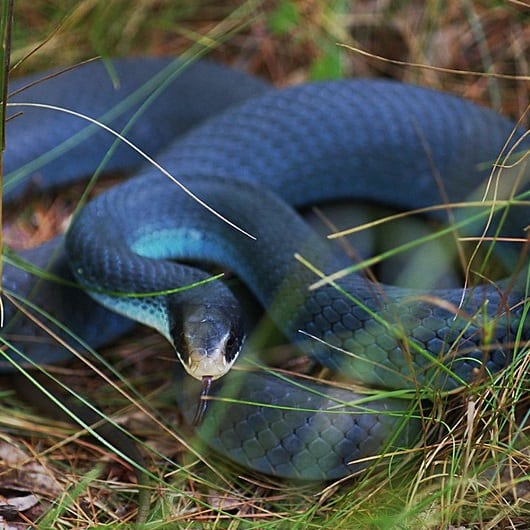Coluber constrictor, commonly called the eastern racer is a nonvenomous snake species. The species contains eleven subspecies that can be found throughout the United States as well as in Hawaii. Alaska is the only state in the U.S. that doesn’t have a population of racers. The racer is a highly active and fast-moving snake. This behavior explains its common name. One of the subspecies of the racer, the northern black racer is the state reptile of Ohio.
Description
Size
An adult racer can reach a size of 36-60 inches (90-150 cm) and weighs 1 lb (500 grams) on average. The largest ever recorded eastern racer was 73 inches (183 cm) long. Male and female racers have about the same size.
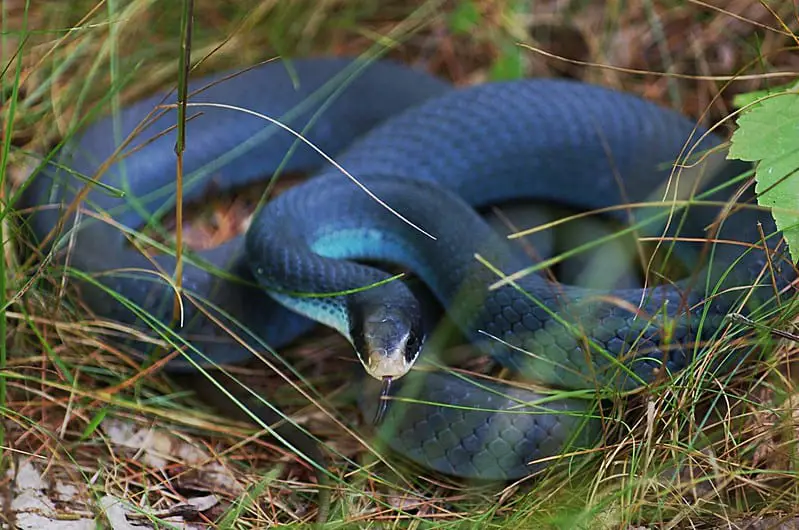
Patterns and Coloration
Most subspecies of racers are solid-colored in dark colored. These can range from green to blue, brown, grey and black. The underbelly of all subspecies is lighter-colored than the rest of their bodies. They have smooth scales.
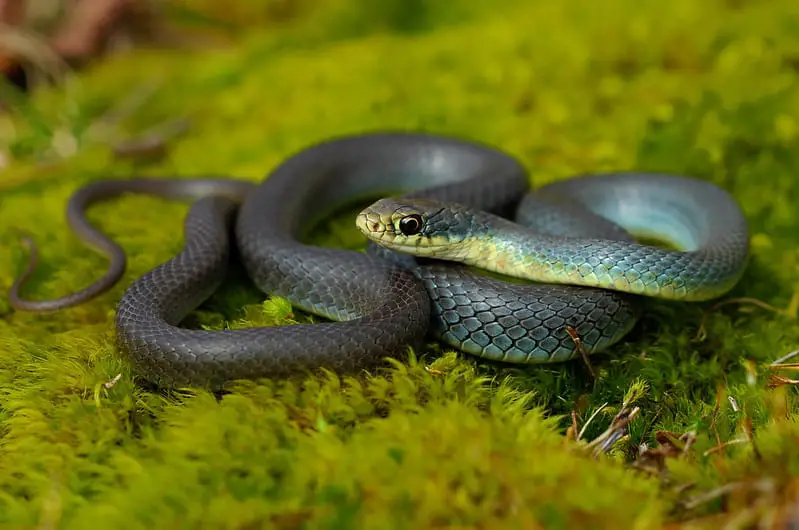
Juvenile racers are more varied and have blotched patterns in various colors on their bodies. After reaching their third summer, they reach maturity and their bodies are changing to a solid, darker color.
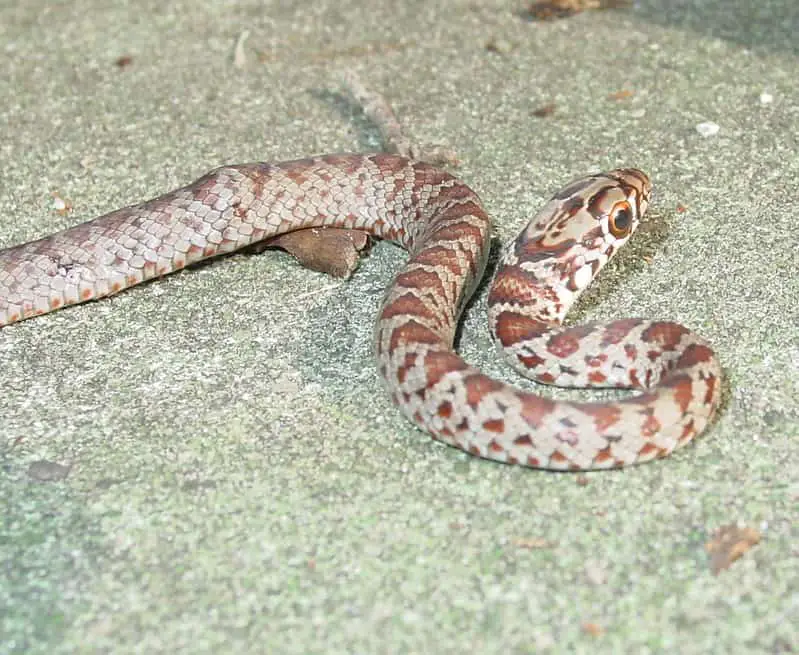
Hunting Behavior
Even though their scientific name suggests Coluber constrictor otherwise, the eastern racer does not constrict its prey. They are using their body to immobilize their prey and often swallow it alive, before soffocating it. Their diet conists mainly of amphibians like toads, frogs and lizards as well as rodents and small birds. Juveniles often eat insects until they become large and strong enough to take on larger prey.
Thanks to their incredible speed, they easily manage to chase and pin down any small animal once they have spotted it.
Bite
The racer is a nonvenomous snake and does not pose any danger to humans or pets. It rarely occurs that humans are bitten by eastern racers since they are incredibly fast and will escape any form of danger. However, if they are cornered and feel threatened, they are a fairly aggressive species that will not hesitate to attack and bite. A bite will only cause a minor discomfort as they have small teeth and do not have any venom glands. Superficial disinfection is always recommended for any wound. Other than that, there is nothing to worry about, when it comes to eastern racers.
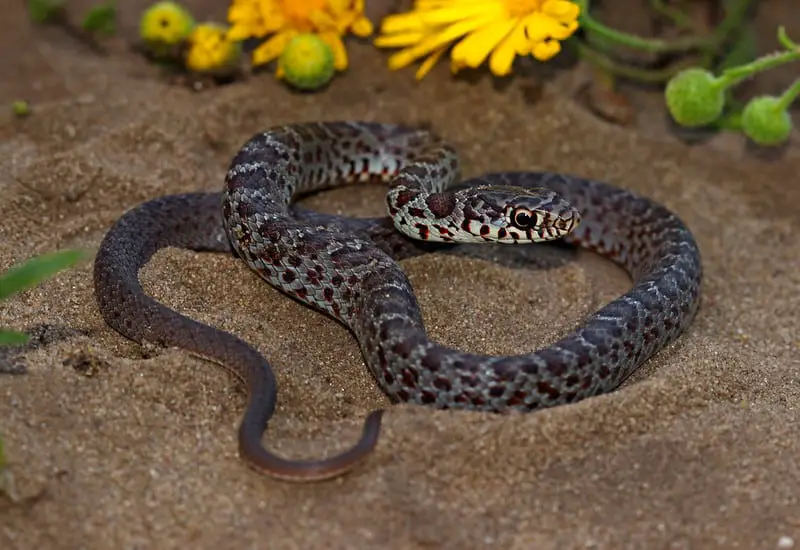
Habitat
The eastern racer prefers to roam around open grasslands where it can spot its prey from a distance and race towards it. Other than in open grasslands and savannahs, they also live in forests and close to human settlements. During the winter months, they hibernate in burrows of small mammals or in rock crevices in the forest.
Racer range in the USA
The largest part of the racer population can be found in the Eastern United States, east of the Rocky Mountains. Therefore, the species is also called eastern racer. However, some of the subspecies have spread to the Western United States as well as to Hawaii. Apart from Alaska, Eastern Racers can be found in every U.S. State. Namely, these are: Alabama, Arizona, Arkansas, California, Colorado, Connecticut, Delaware, Florida, Georgia, Hawaii, Idaho, Illinois, Indiana, Iowa, Kansas, Kentucky, Louisiana, Maine, Maryland, Massachusetts, Michigan, Minnesota, Mississippi, Missouri, Montana, Nebraska, Nevada, New Hampshire, New Jersey, New Mexico, New York, North Carolina, North Dakota, Ohio, Oklahoma, Oregon, Pennsylvania, Rhode Island, South Carolina, South Dakota, Tennessee, Texas, Utah, Vermont, Virginia, Washington, West Virginia, Wisconsin and Wyoming.
Scientific classification of Coluber constrictor
- Kingdom: Animalia
- Phylum: Chordata
- Class: Reptilia
- Order: Squamata
- Suborder: Serpentes
- Family: Colubridae
- Genus: Coluber
- Species: Coluber constrictor
Subspecies
There are eleven subspecies of the racer that can all be found in the United States. Their common names often suggest details of the range and/or their coloration and appearance:
- Buttermilk racer (Coluber constrictor anthicus)
- Northern black racer (Coluber constrictor constrictor)
- Tan racer (Coluber constrictor etheridgei)
- Eastern yellow-bellied racer (Coluber constrictor flaviventris)
- Blue racer (Coluber constrictor foxii)
- Brown-chinned racer (Coluber constrictor helvigularis)
- Black-masked racer (Coluber constrictor latrunculus)
- Mexican racer (Coluber constrictor Oaxaca)
- Everglades racer (Coluber constrictor paludicola)
- Southern black racer (Coluber constrictor priapus)
- Western yellow-bellied racer (Coluber constrictor Mormon)
Other common names
The racer and its subspecies are often also called eastern racer or “runner” instead of racer. That common name also refers to the speed the snake is moving at.
